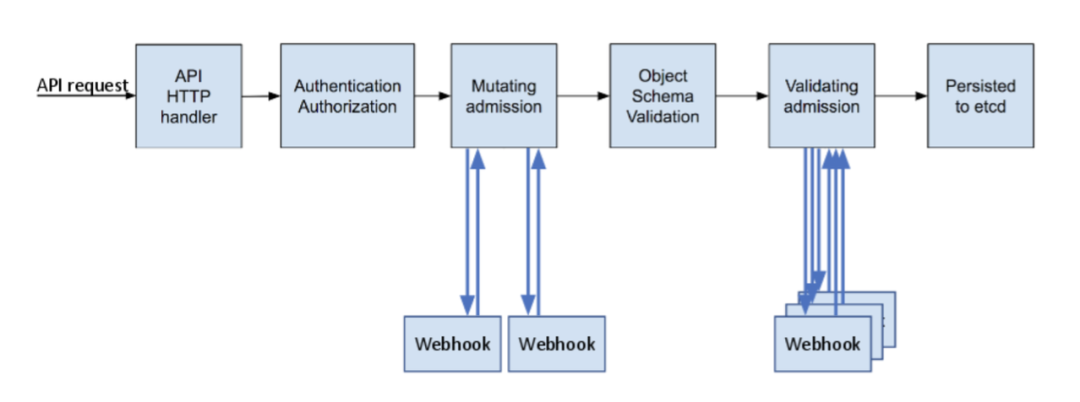简介

Kubernetes 的 apiserver 一开始就有 AdmissionController 的设计,这个设计和各类 Web 框架中的 Filter 很像,就是一个插件化的责任链,责任链中的每个插件针对 apiserver 收到的请求做一些操作或校验。分类
- MutatingWebhookConfiguration,操作 api 对象的, 会对request的resource,进行转换,比如填充默认的request/limit
- ValidatingWebhookConfiguration,校验 api 对象的, 比如校验Pod副本数必须大于2。
使用场景:使用 Admission Webhook 机制实现多集群资源配额控制未读
Admission Controller
准入控制器是kubernetes 的API Server上的一个链式Filter,它根据一定的规则决定是否允许当前的请求生效,并且有可能会改写资源声明。比如
- enforcing all container images to come from a particular registry, and prevent other images from being deployed in pods.
- applying pre-create checks
- setting up default values for missing fields.
The problem with admission controllers are:
- They’re compiled into Kubernetes: If what you’re looking for is missing, you need to fork Kubernetes, write the admission plugin and keep maintaining a fork yourself.
- You need to enable each admission plugin by passing its name to –admission-control flag of kube-apiserver. In many cases, this means redeploying a cluster.
- Some managed cluster providers may not let you customize API server flags, therefore you may not be able to enable all the admission controllers available in the source code.
K8s支持30多种admission control 插件,其中有两个具有强大的灵活性,即ValidatingAdmissionWebhooks和MutatingAdmissionWebhooks,这两种控制变换和准入以Webhook的方式提供给用户使用,大大提高了灵活性,用户可以在集群创建自定义的AdmissionWebhookServer进行调整准入策略。
配置apiserver 发起webhook
apiVersion: admissionregistration.k8s.io/v1
kind: ValidatingWebhookConfiguration
...
webhooks:
- name: my-webhook.example.com
rules:
- operations: ["CREATE", "UPDATE"]
apiGroups: ["apps"]
apiVersions: ["v1", "v1beta1"]
resources: ["deployments", "replicasets"]
scope: "Namespaced"
rules 控制apiserver 何时 因为何种资源 发出请求:上例中 匹配针对 apps/v1 和 apps/v1beta1 组中 deployments 和 replicasets 资源的 CREATE 或 UPDATE 请求
clientConfig 描述如何调用webhook
-
url 方式
apiVersion: admissionregistration.k8s.io/v1 kind: MutatingWebhookConfiguration ... webhooks: - name: my-webhook.example.com clientConfig: url: "https://my-webhook.example.com:9443/my-webhook-path" -
service 方式
apiVersion: admissionregistration.k8s.io/v1 kind: MutatingWebhookConfiguration ... webhooks: - name: my-webhook.example.com clientConfig: caBundle: "Ci0tLS0tQk...<base64-encoded PEM bundle containing the CA that signed the webhook's serving certificate>...tLS0K" service: namespace: my-service-namespace name: my-service-name path: /my-path port: 1234
在volcano 的webhook中,ValidatingWebhookConfiguration 的配置是通过代码写入到 apiserver 的。对于volcano 这种大型框架,可能包含多个crd,每个crd 都会注册一个VatingWebhookConfiguration,adminssion webhook 本身就要统一管理(有一个集中的 adminssion webhook map或slice) 就像controller 之于controller manager。具体到实现某个crd 的adminssion webhook时,只需要在crd 对应的包 init 方法里注册下 就可以,如果是自己写的话,yaml 文件要写五六个。
请求响应参数
webhook本身是一个约定接口的web server。
type AdmissionReview struct {
metav1.TypeMeta `json:",inline"`
// Request describes the attributes for the admission request.
// +optional
Request *AdmissionRequest `json:"request,omitempty" protobuf:"bytes,1,opt,name=request"`
// Response describes the attributes for the admission response.
// +optional
Response *AdmissionResponse `json:"response,omitempty" protobuf:"bytes,2,opt,name=response"`
}
- 向 Webhook 发送 POST 请求时,请设置 Content-Type: application/json 并对 admission.k8s.io API 组中的 AdmissionReview 对象进行序列化,将所得到的 JSON 作为请求的主体。
-
Webhook 使用 HTTP 200 状态码、Content-Type: application/json 和一个包含 AdmissionReview 对象的 JSON 序列化格式来发送响应。该 AdmissionReview 对象与发送的版本相同,且其中包含的 response 字段已被有效填充。response 至少必须包含以下字段:
- uid,从发送到 webhook 的 request.uid 中复制而来
- allowed,设置为 true 或 false
Webhook 禁止请求的最简单响应示例:
{
"apiVersion": "admission.k8s.io/v1",
"kind": "AdmissionReview",
"response": {
"uid": "<value from request.uid>",
"allowed": false
}
}
当允许请求时,mutating admission webhook 也可以选择修改传入的对象。 这是通过在响应中使用 patch 和 patchType 字段来完成的。 当前唯一支持的 patchType 是 JSONPatch。 对于 patchType: JSONPatch,patch 字段包含一个以 base64 编码的 JSON patch 操作数组。例如,设置 spec.replicas 的单个补丁操作将是 [{"op": "add", "path": "/spec/replicas", "value": 3}]。
{
"apiVersion": "admission.k8s.io/v1",
"kind": "AdmissionReview",
"response": {
"uid": "<value from request.uid>",
"allowed": true,
"patchType": "JSONPatch",
"patch": "W3sib3AiOiAiYWRkIiwgInBhdGgiOiAiL3NwZWMvcmVwbGljYXMiLCAidmFsdWUiOiAzfV0="
}
}
ValidatingWebhookConfiguration 妙用
Kubernetes 中如何保证优雅地停止 Pod利用 ValidatingAdmissionWebhook,在重要的 Pod 收到删除请求时,先在 webhook server 上请求集群进行下线前的清理和准备工作,并直接返回拒绝。这时候重点来了,Control Loop 为了达到目标状态(比如说升级到新版本),会不断地进行 reconcile,尝试删除 Pod,而我们的 webhook 则会不断拒绝,除非集群已经完成了所有的清理和准备工作。